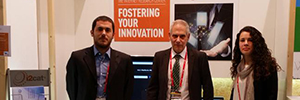i2CAT coordinates the first European project on RINA, the network architecture of the future
RINA, a general theory of network architecture developed by Internet pioneer John Day, would provide the infrastructure needed to support distributed computing.
The Foundation i2CAT will coordinate the European project IRATI, of the 7th Framework Programme, that for two years will work on the development of an efficient implementation of RINA, a general theory of network architecture developed by Internet pioneer John Day. The Foundation is at the forefront of this project thanks to the results obtained after two years of research with Boston University (where John Day is from?), the Irish research center TSSG and the American start-up TRIA Network Systems, forming the Pouzin Society (PSOC), A forum for developing viable alternative solutions to current network architecture.
The RINA architecture offers a solid theory with enough elements to provide the necessary infrastructure to support distributed computing.. This new infrastructure, developed by the PSOC and successfully implemented in two prototypes, It will allow to create a much simpler computer network than the current one and, therefore, more economical to build and operate, Providing at the same time multi-homing, mobility, Multicast and quality of service in users, as well as greater reliability and security of communications. In fact, one of the consequences of using rina is that the number of protocols required to replicate tcp/ip functionality is much lower and, Only in the security area, A reduction in one factor is estimated 10 (for more information on the main obstacles of TCP/IP architecture and the differences with RINA, See attached document).
The IRATI project provides a step forward in the evolution of this technology, since it allows you to dispense with the TCP / IP architecture and get rid of all the limitations offered by solutions developed on top of this large number of protocols. The project will implement John Day's theory about Ethernet for Linux and FreeBSD operating systems.. The code developed will be open to be used for teaching purposes, for academic research but also as a basis for developing future RIN-based products.
Interoute Use Cases
With a budget of 1.126.000 Euros (of which 870.000 are subsidized by European funds), the European project IRATI will have the participation, in addition to i2CAT as project coordinator and technical director, of the Italian SME Nextworks, of the Belgian group iMinds and Interoute, whose collaboration will allow solutions to realistic use cases provided by this telecommunications multinational.
As a project partner, Interoute will provide information on the problems they experience in their day-to-day life when providing their network operator and cloud services services due to the limitations provided by current technology based on TCP/IP protocols.. This information will help the rest of the project members to decide which components of RINA are the most relevant and priority to develop..
To carry out the experimentation and validation of prototypes, IRATI will use the services of the experimental platform OFELIA, project also funded by the European Commission and in which i2CAT also participates, in which it is possible to join different testbeds in several places in Europe (Barcelona, Ghent, Bristol, Berlin, Trento and Zurich, among others).
For Eduard Grasa, responsible for the RINA research line of the i2CAT Foundation and technical manager of the IRATI project, "Although it is operating on an impressive scale., the success and adoption of TCP/IP is not because it is a technological marvel but has more to do with the large amount of money that the U.S. government has to make of the U.S. government. UU. contributed over the years 80 and principles of the 90 to develop this technology and subsidize its operating costs, facilitating its use".
"The problem with IPV6 is that it drags the same errors as its predecessor., is a patch on a patch, But resources could be optimized much better with another type of network architecture, like the one proposed by John Day", ensures Fat and adds: "Using a simile with construction, The project we started now is a new way of doing things; I mean, We are not building a new building but it is a change of technology, The tools and style of construction, through which new buildings can be made much more efficient, sustainable and with many more possibilities to add new functionalities".
Access John Day's full paper on RINA.
You liked this article?
Subscribe to our RSS feed And you won't miss anything.














